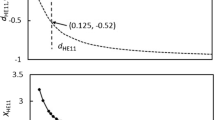Abstract
It has been demonstrated that the dual-wire waveguide (DWW) can be used in terahertz (THz) frequency regime with many advantages. However, the existent research approaches for the DWW are based on the electrostatic theory. In this paper, making use of the bipolar coordinate system (BCS), a rigorous analytical theory of DWW is worked out, and some important physical and optical characters of DWW including the rotating behavior etc. are revealed, the equivalent impendence and the ohmic loss for the gold DWW are calculated. An eigenvalue problem is presented from the point of view of Mathematical-Physics for TE and TM modes. The obtained results will help get a deep-going understanding of DWW and explore its application in high frequency range including THz.
Similar content being viewed by others
References
Wang K, Mittleman D M. Metal wires for terahertz wave guiding. Nature, 2004, 432: 376–379
Mbonye M, Astley V, Chan W L, et al. A Terahertz dual wire waveguide. In: Lasers and Electro-Optics (CLEO) Conference. Baltimore: Optical Society of America, 2007. CThLL1
Mbonye M, Mendis R, Mittleman D M. A terahertz two-wire waveguide with low bending loss. Appl Phys Lett, 2009, 95: 233506
Astley V, Scheiman J, Mendis R, et al. Bending and coupling losses in terahertz wire waveguides. Opt Lett, 2010, 35: 553–555
Zhan H, Mendis R, Mittleman D. Terahertz energy confinement in finite-width parallel-plate waveguides. Terahertz Sci Technol, 2009, 2: 144–149 (http://www.tstnetwork.org)
Zhang K Q, Li D J. Electromagnetic Theory for Microwaves and Optoelectronics. 2nd ed. Berlin: Springer, 2002. 110–122
Elliott R S. An Introduction to Guided Waves and Microwave Circuits. Englewood Cliffs: Prentice-Hall, 1993. 51–60
Pahlevaninezhad H, Darcie T E, Heshmat B. Two-wire waveguide for terahertz. Opt Expr, 2010, 18: 7415–7420
Robert E C. Foundations for Microwave Engineering. 2nd ed. New York: McGraw-Hill Inc., 1992. 96–117
Stratton J A. Electromagnetic Theory. York: The Maple Press Company, 1942. 56–57
Jackson J D. Classical Electrodynamics. 3rd ed. New York: John Wiley & Sons, 1999. 352–356
Moon P, Spencer D E. Separability in a class of coordinate systems. J Franklin Inst, 1952, 254: 227–242
Gerokemicca U V, Zhetlena M U. Tables of Integrals, Series and Differences (in Russia). National, 1963, 56: 461–465
Author information
Authors and Affiliations
Corresponding author
Additional information
ZHONG RenBin received the M S degree in optics from the Southwest Jiaotong University, Chengdu in 2003. Currently, She is a lecturer at the terahertz science and technology research center of University of Electronic Science and Technology of China (UESTC). Her research interests include terahertz sources, terahertz transmission and related components.
LIU WeiHao was born in Hunan province of China in November 1984. He is now the Ph.D. candidate, majoring in physical electronics, of UESTC. His interesting subjects include THz wave generation and transmission.
ZHOU Jun was born in 1980. He received the Ph.D. degree in plasma physics from the University of Electronic Science and Technology of China (UESTC), Chengdu, in 2009. Currently, he is a lecturer at the terahertz science and technology research center of UESTC. His research interests include terahertz sources, terahertz transmission lines, and related numerical simulation methods.
LIU ShengGang Professor of University of Electronic Science and Technology of China (UESTC). He received his Ph.D. degree in physical electronics from UESTC in 1958. He was elected the Academician of Chinese Academy of Sciences in 1980, IEEE fellow in 1990 and member of the Electromagnetic Academy, MIT in 1991. He is member of International Organizing Committee of IRMMW-THz, K.J. Button Prize Committee et al. He serves as the Chair of the International Committee of SICAST. His current interest is the terahertz physics, microwave electronics, relativistic electronics, free electron laser, optics, plasma physic.
Rights and permissions
About this article
Cite this article
Zhong, R., Zhou, J., Liu, W. et al. Theoretical investigation of a terahertz transmission line in bipolar coordinate system. Sci. China Inf. Sci. 55, 35–42 (2012). https://doi.org/10.1007/s11432-011-4488-0
Received:
Accepted:
Published:
Issue Date:
DOI: https://doi.org/10.1007/s11432-011-4488-0




